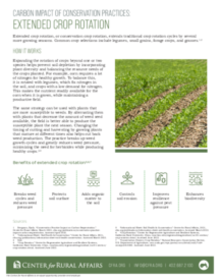Policy
Farm and Food
Extended crop rotation, or conservation crop rotation, extends traditional crop rotation cycles by several more growing seasons. Common crop selections include legumes, small grains, forage crops, and grasses.
Expanding the rotation of crops beyond one or two species helps prevent soil depletion by incorporating plant diversity and balancing the resource needs of the crops planted. For example, corn requires a lot of nitrogen for healthy growth.
To balance this, it is rotated with legumes, which fix nitrogen in the soil, and crops with a low demand for nitrogen. This makes the nutrient readily available for the corn when it is grown, while maintaining a productive field.
See more: No-till | Reduced tillage | Cover crops


